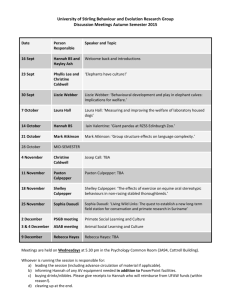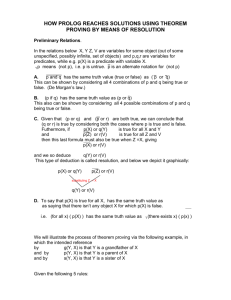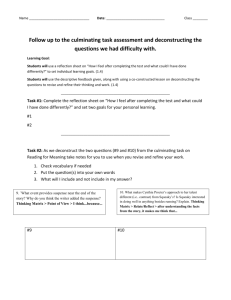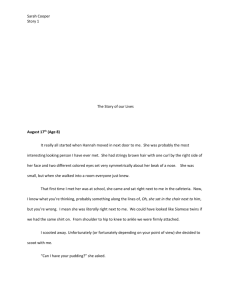PART IV BEFORE GENE THERAPY Mommy, why do you have to go
advertisement
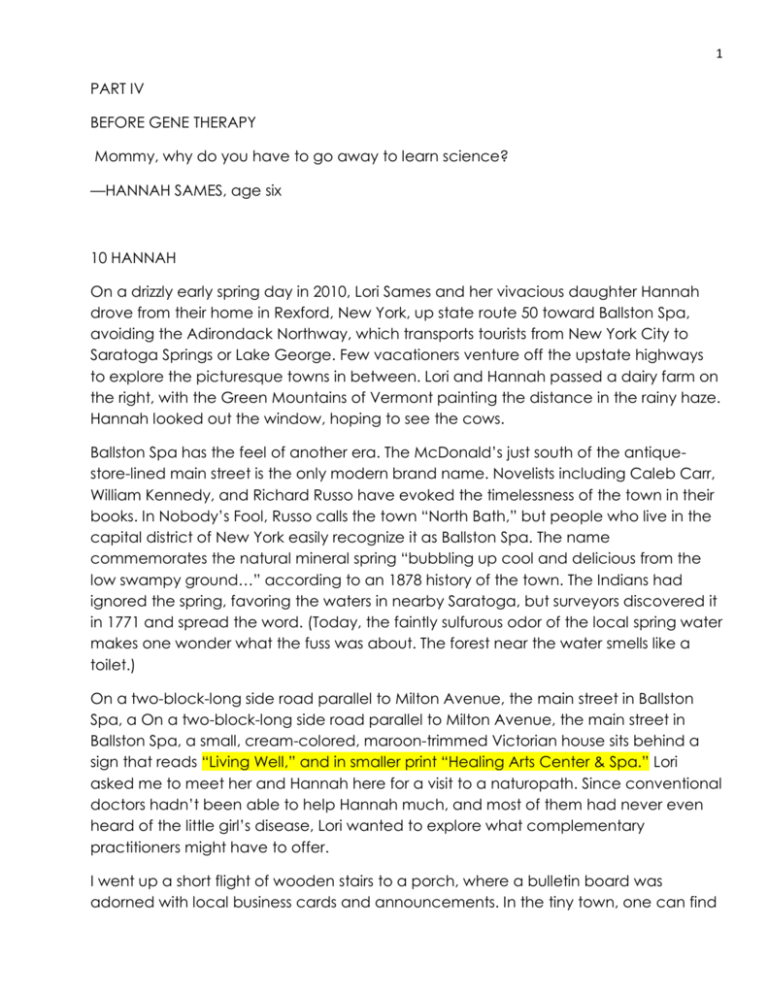
1 PART IV BEFORE GENE THERAPY Mommy, why do you have to go away to learn science? —HANNAH SAMES, age six 10 HANNAH On a drizzly early spring day in 2010, Lori Sames and her vivacious daughter Hannah drove from their home in Rexford, New York, up state route 50 toward Ballston Spa, avoiding the Adirondack Northway, which transports tourists from New York City to Saratoga Springs or Lake George. Few vacationers venture off the upstate highways to explore the picturesque towns in between. Lori and Hannah passed a dairy farm on the right, with the Green Mountains of Vermont painting the distance in the rainy haze. Hannah looked out the window, hoping to see the cows. Ballston Spa has the feel of another era. The McDonald’s just south of the antiquestore-lined main street is the only modern brand name. Novelists including Caleb Carr, William Kennedy, and Richard Russo have evoked the timelessness of the town in their books. In Nobody’s Fool, Russo calls the town “North Bath,” but people who live in the capital district of New York easily recognize it as Ballston Spa. The name commemorates the natural mineral spring “bubbling up cool and delicious from the low swampy ground…” according to an 1878 history of the town. The Indians had ignored the spring, favoring the waters in nearby Saratoga, but surveyors discovered it in 1771 and spread the word. (Today, the faintly sulfurous odor of the local spring water makes one wonder what the fuss was about. The forest near the water smells like a toilet.) On a two-block-long side road parallel to Milton Avenue, the main street in Ballston Spa, a On a two-block-long side road parallel to Milton Avenue, the main street in Ballston Spa, a small, cream-colored, maroon-trimmed Victorian house sits behind a sign that reads “Living Well,” and in smaller print “Healing Arts Center & Spa.” Lori asked me to meet her and Hannah here for a visit to a naturopath. Since conventional doctors hadn’t been able to help Hannah much, and most of them had never even heard of the little girl’s disease, Lori wanted to explore what complementary practitioners might have to offer. I went up a short flight of wooden stairs to a porch, where a bulletin board was adorned with local business cards and announcements. In the tiny town, one can find 2 an expert in Reiki, Pilates, nutrition, or even “interspecies telepathic animal communication,” whatever that is. I was a little early, so I ventured inside for a peek. No one was around, but in this part of the state, we don’t usually lock our doors. Bells tinkled when the front door opened onto a waiting area that had the feel of a pampering spa. The room was elegantly appointed, with comfortable chairs and a delicate floral scent just a few aerosolized molecules short of being cloying. Brochures on tiny tables advertised such services as Tui Na Oriental Bodywork, glycolytic peels, and a variety of facials offering concoctions of collagen, algae, rose, vegetable mud, seaweed, or herbs to be massaged into parched epidermis, or minerals for those with a taste for the inorganic. Steep stairs to the side of the entranceway led to offices and exam rooms of various types of health care practitioners. I was back on the porch perusing the bulletin board a few minutes later when Lori pulled her minivan into one of the diagonal parking spots. She helped Hannah out and they headed toward the porch stairs. Lori has a fresh-faced look, with just a touch of frazzled mom. It takes a moment to notice that something is wrong with Hannah. She’s adorable, with extremely kinky hair and a bright smile. That day she was clad in jeans and a jeans jacket with a pink shirt that echoed the pink barrette holding some of her frizz. Because her legs are slightly bowed, she had difficulty hauling herself up the short flight of stairs, but that and her hair were the only obvious unusual features. By the time school started in September, Lori whispered, Hannah would need a walker, and soon after, a wheelchair. Hannah was here today to address her frequent stomachaches. She’s tiny— a mere forty pounds— with a voracious and odd appetite. That morning, she’d had asparagus, dill pickles, and coleslaw for breakfast. Lori doesn’t know if her daughter’s penchant for strange foods is part of her inherited illness, or just Hannah. Mother and daughter were there to meet with Sarah LoBisco, a naturopath. Hannah also regularly sees speech, physical, and occupational therapists, a psychologist, a chiropractor, a physiotherapist, a neurologist, an orthopedic surgeon, a gastroenterologist, and of course a pediatrician. None of them know much about her condition, but they try to help manage her symptoms. Dr. LoBisco, an attractive, energetic brunette, came downstairs. Poised and friendly, she had an instant rapport with Hannah, who was sprawled on the floor, working a puzzle. We went upstairs, slowly, past two rooms with therapeutic-looking beds in the centers, to an office in the back. Hannah spread her puzzle on the floor while Lori and I drew up chairs. Dr. LoBisco sat at her desk and opened her laptop. A diploma above her indicated that she has a four-year graduate degree from one of only four institutions in the United States certified by the Council on Naturopathic Medical 3 Education. I had no idea what naturopathy was, but LoBisco quickly explained. “Naturopathy taps into the body’s ability to heal itself. It avoids drugs and surgery, and instead of treating symptoms, gets at the root cause of an illness.” Coming from my perspective as a geneticist, I was perplexed. Wasn’t the root cause of an inherited illness a mutation, a change in DNA that only gene therapy can fix? Don’t the tools of naturopathy— eating whole unprocessed foods; taking vitamin, mineral, and food supplements; practicing yoga, meditation, and exercise therapy— look to counter a symptom that a genetic glitch sets into motion? My confusion grew when I later read on the website for the NIH’s National Center for Complementary and Alternative Medicine, “Practitioners seek to identify and treat the causes of a disease or condition, rather than its symptoms.” It was a little like the new cystic fibrosis drugs that are claimed to treat the disease at its source, but which actually target the protein, offering a treatment that is daily, not forever. Semantics aside, the field began with Benedict Lust, who was treated by a natural healer in Germany and brought the approach to the United States in the early twentieth century, christening it naturopathy. This holistic, wellness-centered, noninvasive movement spread for three decades, until antibiotics and other advances in conventional medicine began to outshine it. Naturopathy is popular again today, not as an alternative method of healing, but as a complement to modern medicine— as it is for Hannah. LoBisco listened intently as Lori’s complicated story spilled out in torrents of jargon, typing notes and occasionally googling when the name of a molecule surfaced from the narrative stream. The conversation wandered as Lori flitted from science-speak to mommy-speak to spelling the multisyllabic words so that Hannah, who can read and understand at a level much higher than the norm for her age, wouldn’t catch on. As the doctor guided Lori through a detailed family medical history, a larger picture emerged. Lori described the regimen of alternating dietary oils— wheat germ, evening primrose, black currant seed, sesame, and fish— that Hannah had recently begun. These would support her cell membranes, according to the chiropractor who recommended them. She talked about a food supplement, Neurotrophin, which she chopped up and sprinkled onto Hannah’s food. The stuff is mashed pig brains. The language on the website that sells it is technical and vague at the same time, a curious mix of language that would seem accurate and impressive to anyone who isn’t a biologist. It is sneaky, too. The name of the pig brain extract emulates “neurotrophin,” a real type of nurturing molecule in the nervous system. With a capital letter and a trademark symbol, it sounds like a drug, but it isn’t, because “food supplements” do not need FDA approval to be marketed. 4 As LoBisco googled away, asking questions and offering ideas and suggestions, she and I gradually realized that our areas of expertise are complementary, not in conflict. She talked about probiotics and organic foods, I talked about genes and proteins. Meanwhile, Lori segued smoothly from detailing how a missing protein hugely inflates the axons of Hannah’s nerve cells to a vivid description of the length, consistency, hue, and odor of her daughter’s most recent poop. Hannah sat quietly in the corner, reading, but as the two-hour mark approached, she grew cranky. She was, after all, a six-year-old, although at times she has a pensive look in her eyes that seems older. LoBisco still had a few pages to complete in the history, so she turned her computer around, and Hannah soon had Barbie on YouTube prancing about on the screen. When Hannah stumbled upon a restricted website with naked people, it was time to go. LoBisco ended the session with recommendations to eat organic foods and to try eliminating milk to address Hannah’s stomach pain. She would need time, though, to learn more about Hannah’s disease, so that she could determine whether naturopathy could help. It’s understandable that LoBisco didn’t know anything about giant axonal neuropathy— GAN. Most MDs don’t, either. For there are only forty-five recognized cases in the world, and Hannah Sames is the youngest. Hannah Sames and mother Lori * * * Few disease names have as clear a meaning as GAN— a nerve disease of giant axons. Neurobiology 101: An axon juts from the central cell body of a nerve cell, or neuron, like a tadpole’s tail. On the other side of the cell body bursts an explosion of branchlike dendrites. Looked at lengthwise, a neuron is a little like an out-of-proportion upper limb— the dendrites represent the fingers, the axon the arm, and the cell body the hand itself. If the cell body were the size of an apple, then the brushy dendrites would bloom outward several feet. The axon is considerably longer. Dendrites receive messages and axons send them. 5 A cross section of healthy white matter nerve tissue looks like a sheet of tiny dots when looked at head-on. These dots are aligned axons. In GAN, some of the dots are huge circles, grossly swollen, but they aren’t empty. Hannah’s axons are stuffed with strawlike fibers called neurofilaments. How the axons got that way remains a mystery, despite knowing the root genetic cause. Sporadic descriptions of what might have been GAN dot the medical literature from the 1950s, when it was dubbed a vague “polyneuropathy.” In 1971, researchers at the University of California, San Francisco, discovered the giant axons and named the disease, and noted a curious symptom— extremely kinky, fair hair. Their subject was a six-year-old with a medical history eerily like Hannah’s. She met her early developmental milestones, but by the time she was three, neighbors began to comment on her clumsy gait. The parents were so accustomed to how their little girl walked that they didn’t realize her awkwardness could be an indicator of a larger problem. A physician diagnosed “rheumatism” and advised that the girl take aspirin for a few weeks. If that didn’t help, he’d start a workup for muscular dystrophy. The girl became weaker. In another six months, her legs were unsteady and her feet oddly turned out. She waddled. Then it became difficult for her to hold things. Her speech became slightly slurred, but she still did well in school. Then she could no longer rise from sitting. This was a sign of muscular dystrophy, but a muscle biopsy at age five showed normal muscle structure. Plus, there was no family history of any muscular condition. 6 By the time the child visited the physicians in San Francisco, her legs were more splayed, and she walked hesitantly, on the outer edges of her feet. Her arms and legs were weak and wasting away, but the cords of muscle didn’t jump and lurch as they do in amyotrophic lateral sclerosis (ALS, also known as Lou Gehrig’s disease), where they look like snakes slithering beneath the skin. She could no longer move her toes or flex her feet, and she was beginning to have difficulty moving her fingers. Sensation had faded away. Viewed under a microscope, her kinky hair was unlike the corkscrew curls of other inherited conditions, such as Menkes disease. Whatever their young patient had, the doctors knew it hadn’t been described before. When they sampled a bit of nerve tissue from near her ankle and looked at it in cross section, they were shocked to see what resembled Swiss cheese: axons of varying sizes, some swollen to “enormous proportions.” The researchers described “massive whorls” and “tightly woven … parallel skeins” of neurofilaments that had squished other cell parts to the sides. As a result, the muscles in the child’s limbs weren’t receiving signals to contract. Three years later, another case appeared in the medical literature from a different group of researchers, who urged doctors to suspect GAN “in a patient with tightly curly, pale scalp hair, unlike that of his parents.” By 1987, only twenty more cases had been reported. That year, researchers from the University of Vermont described a twelve-year-old girl who was sicker than the original six-year-old and Hannah. She had problems crawling, couldn’t walk until age two, and was crashing into things by age three. But she also had heart problems, scoliosis, incontinence, early puberty, and her eyes flitted back and forth. When neurologists reported families with two affected children in 1998, it became clear that the disease was inherited, and the fact that these two dozen patients recognized so far were children was ominous. However, also nestled into the medical literature were reports of adults with symptoms similar to those of inherited GAN from families without other cases. For them, the cause might be exposure to certain chemicals. “Glue sniffer’s neuropathy” from solvents and “leather cement poisoning” from acrylamides in the shoe industry are but two causes of environmentally induced GAN. By 2000, a research team from several European nations had found enough affected families to search for a DNA sequence that the children with GAN had in common. This is a standard experimental approach in genetics, dating back to the first genetic map circa 1984—meticulously compare DNA sequences among people with an illness, and with those of healthy individuals, perhaps the patients’ unaffected siblings. Then search for mutations seen only in the sick kids. The next step is to determine if the function of the specified protein makes sense, given the symptoms, and this stage may require more experiments and/ or lucky or creative thinking. For GAN, such a gene 7 search led to chromosome 16, to a DNA sequence that provides the instructions for cells to make a protein colorfully named gigaxonin. Hannah is missing part of that gene in each of her two chromosome 16s. She got one copy from Lori, and one from her father, Matt. If it was normal, Hannah’s gigaxonin would keep the protein filaments in her motor neurons neatly aligned, so that the cells could effectively reach from her spinal cord down to her toes. Instead, some of her motor neurons are a bloated mess. GAN gene location 16q24 * * * Chaos reigns in the foot long nerves that reach down Hannah’s legs. The problem lies in the scaffolding that gives a cell its characteristic shape. The cytoskeleton— literally “cell skeleton”— has girders of three sizes. The smallest and the largest girders are each made of one kind of protein, but the medium-sized girders, the intermediate filaments, include at least five types of proteins in nerve cells. In hair, they have a different ingredient list, and it is the same recipe as that for nails, horns, and hooves. Hannah’s intermediate filaments are in great disarray. Early on, they only kinked her hair. Now, neurofilaments are filling the axons of her nerve cells, slowly shutting down their ability to communicate with her muscles. An axon looks like a tail, but it doesn’t swish to move the nerve cell of which it is a part. Instead, an axon enables the neuron to transport messenger (neurotransmitter) molecules from where they are made in the nucleus to the outer reaches of the cell, the very tip of the axon, from which the molecules are released into the tiny gap, or synapse, between the neuron and another neuron or a muscle cell. The neurotransmitter molecules bind to these “postsynaptic” cells, triggering triggering electrical changes that spread the message. Such neurotransmission is a complex choreography that goes awry in many diseases. 8 The neuroscientist Tony Brown, PhD, heads a lab at the Center for Molecular Neurobiology at Ohio State University that studies normal neurofilaments, in hopes of discovering what goes wrong in diseases such as ALS and GAN. He describes a healthy axon: “Everything in the axon is moving. It’s a massive highway with thousands of pieces of cargo, moving at different rates, powered by different motors, regulated in different ways. Some of the cargo has a destination, like being shipped to the axon’s end to deliver a message to a muscle cell or another neuron. Other cargo move more slowly and intermittently and not to a particular destination, just replenishing things. Neurofilaments are probably these. Such a complex highway is tremendously vulnerable. Perturbing the momentum over time results in logjams.” Dr. Anthony Brown Hannah’s neurofilaments are horrifically deranged, both too many and too large. Developing a treatment starts with understanding how the abnormal gigaxonin protein affects axons of the motor neurons and causes the symptoms. This is where “animal models” come in, other species that naturally have a disease of humans, or do so because we alter them to have certain human genes. GAN mice are helping researchers to understand what goes wrong in children with GAN. While the rodents aren’t nearly as sick as the children, their axons are far from normal. Yanmin Yang, MD, PhD, at Stanford University leads one of three groups of researchers worldwide who have made GAN mice. The investigators start with genetically identical mice and then remove, or “knock out,” the GAN gene in only some of them. Like Hannah, Yang’s altered mice lack enough of the gigaxonin gene to hamper the ability to move. These mice, by six to ten months of age, are not as active as their healthy littermates and have a barely noticeable shift in gait. Gradually, their back legs splay as they weaken and the rodents may become spastic and develop seizures. The GAN mice also have curly red hair, baldish spots of bent hairs, and no whiskers, and they drag their rear ends. By a year of age, muscle wasting and weight loss worsen, and the mutant mice stumble about their cages. However, most survive until twenty months, which is about the equivalent of a person living into his or her sixties. Looked at under a microscope, the neurons of the sick mice have big axons. They have fewer than their human counterparts who have GAN, but the axons are stuffed tightly with neurofilaments and tiny bubbles stuck in the logjam. 9 Dr. Yanmin Yang Understanding how a disease develops entails understanding what the implicated gene normally does in affected cells. To do that, Dr. Yang looked at normal gigaxonin protein in brain cells from healthy mice. She found that one end forms a propeller that touches another type of protein that in turn controls how the nerve cell handles the normal buildup of protein debris. Healthy gigaxonin regulates levels of that garbagecontrol protein, which maintains the sleek structures of the cell’s scaffolding. Without gigaxonin, the cell’s garbage control lifts, and the scaffolding overgrows, bulging the axon. (When Lori mentioned this finding to Dr. LoBisco, the naturopath, she googled for food supplements that might affect the garbage-control protein. So she was looking at a “cause of the illness,” albeit one removed from the gene itself, but recommending a supplement based on an educated guess, not the findings of a controlled clinical trial.) GAN mice might have an easier time than GAN humans for a practical reason— the animals distribute their weight onto four limbs, while humans, perhaps, stress their two legs enough to cause severe symptoms. But the really good news about Yang’s GAN mice is that they live near-normal life spans. Might children, too? * * * On March 5, 2004, when Lori and Matt first glimpsed their newborn daughter Hannah’s kinky ringlets, they were both delighted and puzzled. Their other daughters, Madison, five, and Reagan, two, had stick-straight hair, as do Lori and Matt. When the birthing goop had dried, Hannah’s curls were odder still, weirdly dull, like the “before” photograph in an ad for a hair conditioner. For a long time, Hannah seemed normal. She smiled, sat, crawled, and hauled herself upright on schedule. The first sign that something might be wrong wasn’t even very alarming. Hannah’s Grammy Judy noticed that the toddler was taking halting, hesitant footsteps. The grandmother thought it was probably just the uncertainty of going from crawling to walking. But instead of becoming more sure of herself and coordinated, Hannah slowly grew clumsier, as the strength ebbed from her legs. Lori took her to an orthopedist and a podiatrist, who reassured her that Hannah would be fine. But 10 already, feathery filaments of protein were filling the long axons in her legs, blocking the nerve impulses to her muscles. Hannah grew into a charming little girl who loved to sing and dance, dress and undress her Barbie dolls, and play outdoors with her sisters, “a beaming light of love,” says her mother. But by Hannah’s third birthday, Lori and Matt suspected something was seriously wrong. Their daughter didn’t walk normally, she tottered, her lower legs bowing out. Her pediatrician gave her a rigorous physical exam and agreed her walking was off, but, like the two physicians before, told the anxious parents, “That’s just how Hannah walks.” She’d likely outgrow it. Unconvinced, Lori took Hannah to another orthopedist. Diagnosis: “Just let her live her life.” She would be fine. The unspoken diagnosis: helicopter mom syndrome. Lori and Matt remained certain that something was wrong, as only parents who watch a child 24/ 7 can. Then came the break. “My sister showed cell-phone video of Hannah walking to a physical therapist she works with who thought Hannah’s gait was like that of a child with muscular dystrophy,” Lori says. Since muscular dystrophy is an inherited muscle disease, the local pediatrician then referred Hannah to a neurologist and a geneticist, and six months of testing for various nerve and muscle diseases ensued. The results: all normal. But Hannah wasn’t normal at all. Lori will never forget the moment when she learned what her little girl had. The answer didn’t come from a DNA test or a medical scan, but from an astute pediatric neurologist. “He took out a huge textbook and showed us a photo of a skinny little boy with kinky hair, a high forehead, and braces that went just below the knee— he looked exactly like Hannah. And he had GAN.” Parents of very sick children remember diagnosis dates in the way that everyone remembers birthdays or dates of death. Hannah Sames was diagnosed on March 24, 2008. The next day the family headed down to a New York City children’s hospital for three days of tests and exams to confirm the diagnosis. The workup was more intense than assessing gait, including biopsies and spinal taps. And the neurologist with the huge textbook turned out to be right. Back home, Lori and Matt met with a genetic counselor, and that is when the devastation really set in. A genetic counselor is a health care professional who explains how genetic illnesses happen, from the molecular particulars to the big picture. Lori gets a faraway look in her eyes as she recalls that session and dully recites what they learned. 11 “Matt and I are each carriers of GAN, and we passed the disease to Hannah. Each of our two other daughters has a two-in-three chance of being a carrier. GAN is a rare ‘orphan genetic disorder’ for which there is no cure, no treatment, no clinical trial, and no ongoing research.” “So you are telling us this is a death sentence?” Lori recalls asking the genetic counselor. “Yes,” she answered quietly. The disease would progress slowly, the counselor continued. Hannah’s legs would gradually weaken. By first grade she’d likely need a walker in addition to her ankle supports, and soon after, a wheelchair. She might lose her sight and hearing, and eventually be bedridden. Matt and Lori walked around like zombies for a few days. Then, like the Salzman sisters who dropped everything to form Stop ALD, and Michaela and Augusto Odone before them who developed Lorenzo’s oil, the Sameses became activists, fund-raisers, and amateur scientists. For their disease— GAN— had no Michael J. Fox, no Christopher Reeve, not even a Lorenzo to fortuitously interest a filmmaker. What pharmaceutical company would be interested in treating a disease that affects a few dozen individuals? Unlike the Salzmans, Matt and Lori had no connections to the scientific community or the biotech or pharmaceutical industries. Nor was a gene therapy already in the works, as it was for Corey and Ashi. Matt and Lori would have to attack the mysterious illness alone, and from scratch.



